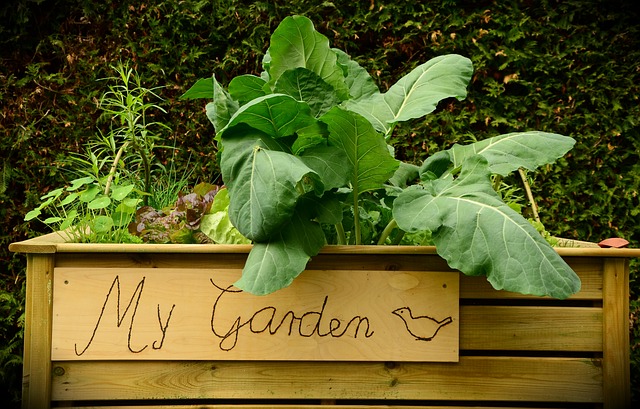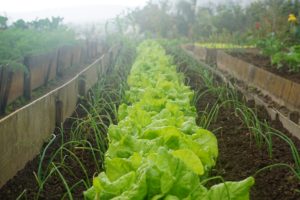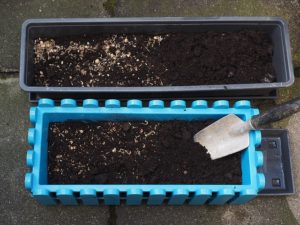Raised Bed Gardening for Hot Climates

Over the years, I’ve learned a lot about gardening in hot climates like the Arizona desert. It doesn’t take long to figure out that trying to plant vegetables in a desert soil just doesn’t really work. Due to our lack of water our soil is severely lacking in organic matter and has a high PH. Growing up in the Midwest, you could basically just till the soil and plant the seeds. Now that I’m living in an urban hot climate, raised beds is the way I grow my vegetables.
Why Garden in raised beds?
- You have poor natural soil
- Better Drainage
- Can be utilized in small spaces
- Easier to manage
- Soil doesn’t compact
- Don’t have to bend quite as far
- Can be fun for kids
- Can grow with others and each have your own space
- Easier to keep weeds under control
- Look good in the yard
Reasons for Planting in a Raised Bed

You have poor natural soil
In the desert southwest we have clay soil, which has virtually no organic material, which means very little soil life. It makes it hard for plants to take up nutrients and get the things they need to flourish without fertile soil.
Better Drainage
This is going to be a common theme with our clay soil, but it tends to retain moisture for a long period of time, and doesn’t allow for much oxygen to get to the roots. This can pose problems with root rot and other diseases. Raised beds allow more control over the soil and you can keep the soil looser for aeration.
Can be utilized in small spaces
You can have a tiny raised garden bed for a few vegetables or herbs that could be on a porch. Raised beds are great for urban backyards that tend to be limited in space.
Easier to manage
You don’t have to worry about tilling the soil or weeding a large area. Everything is contained in a small area which makes it convenient to work with.
Soil doesn’t compact
Our clay soil with our dry heat tends to compact which makes it hard for it to absorb water. Water tends to just run off the surface, unless you slow drip water for a long period of time. In a raised bed, the soil quality is better which helps it to stay loose.
Don’t have to bend as far
It helps to save on your back when you don’t quite have to bend as far to the ground. Some raised beds can be elevated to where you are hardly bending at all.
Can be fun for the kids
You can customize a raised bed that the kids can call their own. It’s exciting to get your kids involved in the garden so they can reap the internal rewards and external harvests that come from gardening.
Can grow with others and have your own space
Community gardens have become fairly popular. Utilizing raised beds can help you have your on section to work within a community of gardeners.
Easier to keep weeds under control
Since you are working with a smaller area, it’s easy to keep the area clean. Also, if the bed is off the ground or the box is providing a barrier it can keep some of those weeds out.
Looks good
A lot of what people enjoy from gardening is the beauty it creates. Raised beds can be decorated or constructed to be aesthetically pleasing to the landscape.
How Do I Build a Raised Garden Bed
A raised bed is fairly simple to construct. My two main raised beds are 8 feet long by 4 feet wide and 2 feet tall.
All I did was purchase 12- 8 feet by 12 inch by 2 inch width boards to make the two raised beds. I cut 4 of the boards in half for the ends.
I used a drill to drill 3 holes vertically on each end and drilled wood screws in the board to form the frame. I then created the additional frames and stack them to the desired height.
You can use brackets if you prefer to secure the frames together, but don’t have to. Once filled with dirt, the boxes won’t shift.
Prepping the Bed

Ensure that the area where the raised bed will be going is level and clear of any debris. If it’s a grassy area, I’d till the area first and make sure to get all the grass roots out.
If it’s just dirt, I’d still loosen the soil to make it easier for the garden soil to eventually seep down into the native soil. I’d recommend finding some high quality soil in your area to fill the box.
Having good soil is critical to having an abundant harvest. I used a local company and purchased a truck load of soil. It was a lot of work to move the soil from my driveway to the raised beds, but definitely worth it.
I top my raised beds with worm castings, compost, and coconut coir. Check out some of the products I use and recommend here. I also have a post on how I annually prep my raised beds.
How deep should a raised bed garden be?
I would recommend a depth of at least 12 inches. Most vegetable root systems aren’t extremely huge, but some still can root fairly deep into the soil.
If your bed is just on top of native soil, than 12 inches is perfectly fine. It’ll be ok if some of the roots go into the ground.
Over the years the fertile soil from the raised bed will continue to work into the native soil making it better suited for growing.
If you’re using an above ground bed or have something along the bottom of the bed, than I’d use something deeper than 12 inches.
What Should I Plant in a Raised Bed?

In the Arizona desert, we have two planting seasons. The Spring planting starts towards the end of February, while the fall planting begins in late September.
I’ve grown peas, beans, lettuces, kale, spinach, carrots, dill, fennel, broccoli, cabbage, peppers, watermelon, honeydew melon, cantaloupe, cucumbers, cauliflower, zucchini, tomatoes, fava beans, and beets successfully in my raised garden beds.
You can pretty much grow any type of herb, flower, shrub, vegetable, or vine in a raised bed.
Planting in a Raised Bed

To maximize the space you have, it’s a good idea to plot out what you intend to plant either on paper or computer. Knowing how much space various plants will take up will help you to get the most out of your raised beds.
For example, melons take up a lot of space. So this past Spring, I dedicated one entire bed for just my melons, while the other bed had tomatoes, peppers, herbs, and zucchini.
I also consider what plants do well together. Check out the guide below for companion planting. On the ends and edges of my raised garden beds, I tend to plant flowers and herbs. I do this to plant things that will attract bees and pollinators to the garden.
Also, planting various things that repel certain pests will benefit your garden. It’s a good idea to follow the seed packets to give you an idea of how to properly sow the seeds. Some seeds like to be planted shallow or on top of the soil, while others like to be planted deeper into the soil. Some plants prefer to grow on a mound, while others in rows.
-
- Plants that Repel Aphids- Dill, Fennel, Chives, Garlic, Marigolds
-
- Plants that Repel White Flies- Marigolds, Nasturtium, Basil, Thyme
- Plants that Repel Squash Bugs- Dill, Spearmint
|
Vegetable |
Goes Well With |
Doesn’t Like |
|
Asparagus |
Tomatoes |
None |
|
Beans (Bush or Pole) |
Celery, corn, cucumbers, radish, strawberries and summer savory |
Garlic and onion |
|
Beets |
Bush beans (not pole beans), cabbage, broccoli, kale, lettuce, onions, garlic |
Pole beans |
|
Cabbage Family (cabbage, broccoli, kale, Brussels sprouts) |
Beets, celery, dill, Swiss chard, lettuce, spinach, onions, potatoes |
Pole beans |
|
Carrots |
Beans, tomatoes |
None |
|
Celery |
Beans, tomatoes, cabbages |
None |
|
Corn |
Cucumber, melons, squash, peas, beans, pumpkin |
Tomatoes |
|
Cucumber |
Beans, corn, peas, cabbage |
None |
|
Eggplant |
Beans, pepper |
None |
|
Melons |
Corn, pumpkin, radish, squash |
None |
|
Onions |
Beets, carrots, Swiss chard, lettuce, peppers |
All beans and peas |
|
Peas |
Beans, carrots, corn, cucumbers, radish, turnip |
Garlic, onions |
|
Potatoes |
Beans, corn, peas |
Tomatoes |
|
Squash |
Corn, melons, pumpkins |
None |
|
Tomatoes |
Carrots, celery, cucumbers, onions, peppers |
Corn, potatoes, kohlrabi |
All in all, gardening in raised beds can almost be a necessity in some parts of the world, like hot, dry climates. When following some simple guidelines anyone can have immediate success using raised garden beds. Raised beds offer the versatility that provide many urban gardeners with bountiful backyard crops.
Please comment below on anything that you enjoyed from this post or your experiences with raised bed gardening.
